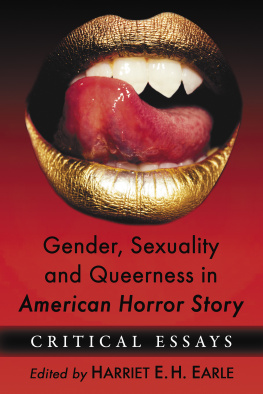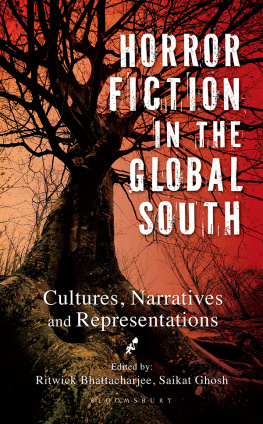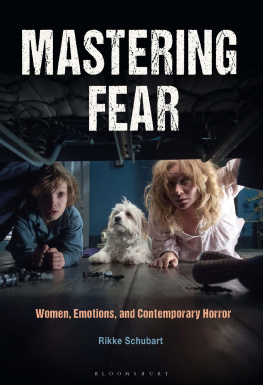
Gender, Sexuality and Queerness in American Horror Story
Critical Essays
Edited by HARRIET E.H. EARLE

McFarland & Company, Inc., Publishers
Jefferson, North Carolina
The essay A Convenient Place for Inconvenient People: Madness and Sex in Asylum by Harriet E.H. Earle was originally published in The Journal of Popular Culture (Vol. 50 No. 2) under the title A Convenient Place for Inconvenient People: Madness, Sex and the Asylum in American Horror Story. It is reprinted here with permission from John Wiley and Sons.
LIBRARY OF CONGRESS CATALOGUING DATA ARE AVAILABLE
BRITISH LIBRARY CATALOGUING DATA ARE AVAILABLE
e-ISBN: 978-1-4766-3682-5
2019 Harriet E.H. Earle. All rights reserved
No part of this book may be reproduced or transmitted in any form or by any means, electronic or mechanical, including photocopying or recording, or by any information storage and retrieval system, without permission in writing from the publisher.
Front cover photograph by Volodymyr Tverdokhlib (Shutterstock)
McFarland & Company, Inc., Publishers
Box 611, Jefferson, North Carolina 28640
www.mcfarlandpub.com
Acknowledgments
The contributors and I would like to extend our warmest thanks to everyone who has made this volume possible: our proofreaders, idea-bouncers, colleagues, friends, and family. We would also like to give a huge thank you to the editorial team at McFarland for their support, guidance and enthusiasm for our project.
As editor, I would like to thank several colleagues for their assistance and encouragement. Dr. Jessica Clarks input was invaluable in the contributor selection and early-stage editing; I am also indebted to her for her help in putting the proposal and initial documents together. Thank you to Sheffield Hallam University for offering research support, with special thanks to Professor Chris Hopkins and Dr. Niamh Downing.
Introduction
Queering American Horror
HARRIET E.H. EARLE
A topless gay man is suspended by chains around his wrist, being viciously beaten by two women. As he is beaten, he screams names (Rip Taylor! Larry Kramer! Greg Louganis!) and smiles broadly. The women, both dressed in modest Victorian costume, are confused by his reaction and angered by his lack of fear and pain. They cease beating him. The reason for his beating is clearhe is one of the last remaining humans after the apocalypse, part of a group of supposedly elite (read: wealthy) individuals corralled within an underground bunker that is controlled by a cruel and sexually repressed matriarch, Ms. Venable. It is she who sets the rules for the bunkers residents, the strictest of which is a total ban on all intimate contact. This manMr. Gallant, a celebrity hairdresserhas been reported for engaging in sex. His partner, we assume, is male although their face is never seen. However, it is not important. The beating is a punishment for engaging in any sex act, regardless of the sex of ones partner. This scene occurs in the second episode of the eighth season of the acclaimed FX horror series American Horror Story (henceforth AHS), subtitled Apocalypse, a series with a long and complex history of representations of violence, gender politics and queerness. A scene in which a flamboyant gay man is beaten by women, while pay[ing] tribute to the great gay radicals of the 70s and 80s, has several potential readings (The Morning After).
The most liberal and optimistic reading sees this as the culmination of the varied and often nuanced representational strategies that have formed the backbone of the series since its inception. Mr. Gallant is not being punished for being gay, hes being punished for having sex, something we assume would happen to straight characters too, were they found in flagrante delicto. His orientation is not the issue at all, suggesting that same-sex relationships are being given equal weight to heterosexual ones. This reading, though positive, smacks of naivet. It would be more accurate to say that, although his orientation is not the reason for his punishment, this scene does still portray a gay man being punished for engaging in sexa phenomenon common on the small screen, as I discuss in due course. Furthermore, his partner is wearing a rubber BDSM suit and mask. This is the same suit that first appears in season one, Murder House. It is purchased by Chad, in an attempt to seduce his boyfriend, Patrick, before being worn by teenage Tate to commit acts of sexual violence against characters of both genders. The rubber man suit is thus not simply a mask to conceal the identity of Mr. Gallants partner; it is a symbol of sexual violence, domination and deviance within AHS that taps into the history of queer stereotyping and also the iconography of the series itself. Engaging in consensual, albeit violent, intercourse with the rubber man, Mr. Gallants actions demonstrate the complexity of representations of sexuality and sexual expression, as well as the myriad interpretative routes one can take when reading through a queer or gender theory lens.
AHS first aired on FX in 2011 and has run, thus far, for eight seasons. It has received 60 awards and over 250 nominations, as well as prompting significant critical and cultural debate. The premise of the show is simpleeach season revolves around a trope or theme common to the horror genre, with a cast of characters taken from both stock archetypes and historical personages. The common thread running through each season is the appearance of these historical figures who, without exception, are taken from the dark and depraved parts of American history, including serial murder, slavery, witchcraft, folklore and cultic violence. Its cast of semifictional historical figures and recognizable horror tropes and narratives is set across sites in the United States of America at varying points in time. The series taps into much debated areas of cultural concern including the rise of television, fame and celebrity culture, family formations and dynamics, mass shootings, and contemporary politics, to name a few. Its use and parody of traditional characters in horror such as the voodoo priestess, the murderous clown, wealthy psychopaths and calculating serial killers has prompted much debate, as have the sites in which it is set, including early 20th century traveling freak shows, the asylum, the hotel and the haunted house.
Television audiences are by now used to seeing violence against LGBTQ characters in mainstream and prime time programming. The phenomenon of using LGBTQ characters as victims of (often extreme, often sexual) violence is so prevalent that there are a number of terms coined to describe it: the Bury Your Gays trope and Dead Lesbian Syndrome are two of the most common. The LGBTQ publication Autostraddle considered nearly 2,000 scripted American television series in the 40-year period between 1976 and 2016. Of these, 193 featured female queer characters and in 35 percent of cases, these characters died; a happy ending occurred in only 16 percent of cases (Hogan n.p). This is by no means an exhaustive study, but it provides some startling numbers. As several of the essays in this collection note, the world of AHS is a dangerous place to be an LGBTQ character, and there are no guarantees of a happy endingor even that the character will make it to the end of the season alive. Furthermore, representations of queer couples are not typically positive. In line with the assertions of Hannah Mueller, representations of sex between men is rarely anything but an act of violence (11).
Next page





![Matt Cardin - Horror Literature Through History [2 Volumes]: An Encyclopedia of the Stories That Speak to Our Deepest Fears](/uploads/posts/book/119545/thumbs/matt-cardin-horror-literature-through-history-2.jpg)

